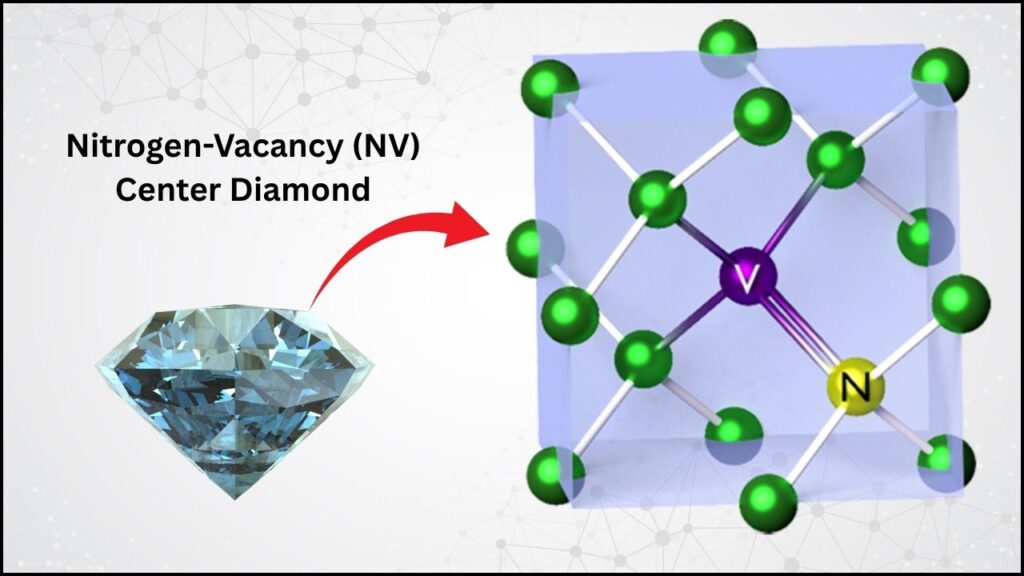If you could fit the lighting power of all the projectors at a movie theater into a tiny sticker inside your smartphone, you’d get close to the magic of metasurfaces. These remarkable devices—thinner than a human hair—can bend, split, and twist light in ways that were impossible with old-school optics. In the world of quantum computing, where speed and accuracy are everything, metasurfaces are making noise because they might be the key to unlocking quantum’s true potential, making computers millions of times faster and packing them into devices as small as your phone.

But why now? Quantum computers have always promised to revolutionize everything from drug discovery to cryptography, but they’ve been held back by size, instability, and complexity. Enter metasurfaces: flat, stable, and programmable chips that can do what a room full of lasers and mirrors used to do, but with no moving parts, no alignment headaches, and a much smaller price tag. The latest research shows just how far this technology has come—and why it matters for everyone from scientists to students, inventors to investors.
Table of Contents
Metasurfaces Could Be the Future of Quantum Computing
| Feature | Traditional Quantum Optics | Metasurface-Based Quantum Hardware | Why It Matters |
|---|---|---|---|
| Size | Bulky, room-sized setups | Chip-scale, portable devices | Enables quantum tech outside the lab, even in everyday gadgets |
| Stability | Sensitive to vibrations, temperature | Robust, no moving parts | Quantum computers that work in the real world, not just climate-controlled labs |
| Entanglement | Complex, multi-component systems | On-chip, simple, scalable generation | More qubits, more quantum power, faster breakthroughs |
| Programmability | Fixed functions | Reprogrammable, algorithm-in-hardware | One device, many quantum tasks—flexible, cost-effective solutions |
| Loss & Error | High optical loss, alignment errors | Low loss, error-resistant designs | Longer-lived quantum states, more reliable computations |
| Integration | Difficult to combine with electronics | Easily integrated with sensors, networks | Quantum sensors, internet, and hybrid devices become possible |
| Applications | Limited by complexity | Quantum imaging, secure comms, anti-counterfeiting, analog computation | Broader commercial, scientific, and industrial use |
Metasurfaces are poised to bring quantum computing out of the lab and into the real world, making it smaller, sturdier, smarter, and more accessible. While technical challenges remain, the pace of research is breathtaking—and the practical implications are enormous.
If you’re curious about technology, science, or the future of computing, keep an eye on metasurfaces. They might just be the key to unlocking quantum’s full potential—and changing the world in the process.
What Exactly Is a Metasurface?
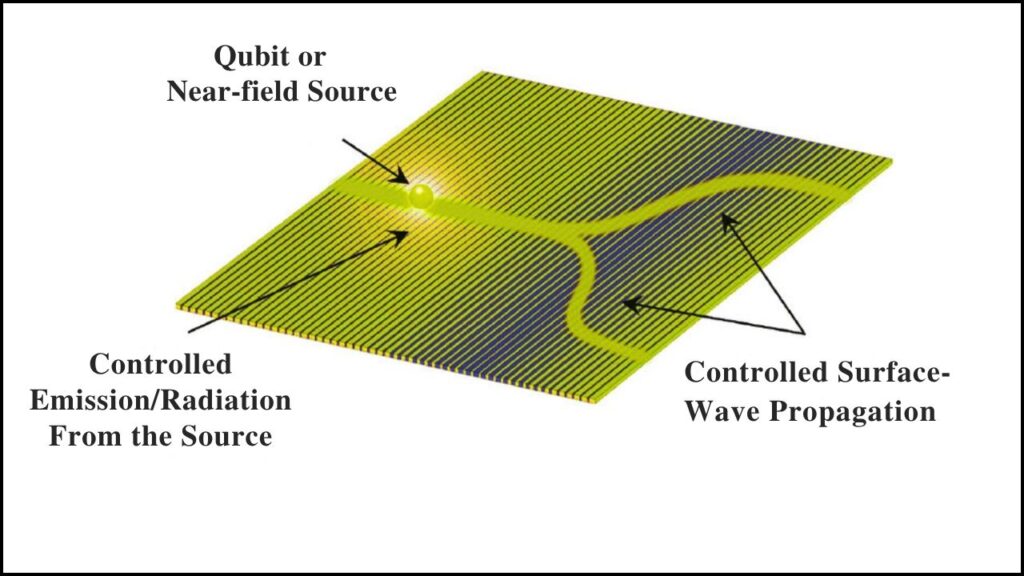
Imagine a postage stamp covered with millions of tiny, microscopic antennas—each one smaller than a wavelength of light. Each “antenna” (technically called a nanostructure) can individually interact with light, shifting its phase, amplitude, or polarization as it passes by. By arranging these nanostructures in precise patterns, engineers can control light with pixel-perfect accuracy, all on a flat, thin chip.
Metasurfaces are, in effect, the next generation of lenses and prisms. But instead of being made of polished glass, they’re manufactured using advanced nanofabrication techniques, etching patterns into materials like silicon or metal. This process allows for customization down to the nanometer scale, making possible optical effects that were previously unthinkable—including the creation, manipulation, and measurement of quantum states of light.
How Metasurfaces Fit into Quantum Computing
Quantum computers rely on qubits—quantum bits—which can be particles of light (photons) for some architectures. Unlike classical bits, qubits can be entangled: when two photons are entangled, measuring one instantly tells you the state of the other, no matter how far apart they are. This “spooky action at a distance,” as Einstein called it, is what gives quantum computers their unbeatable speed for certain tasks.
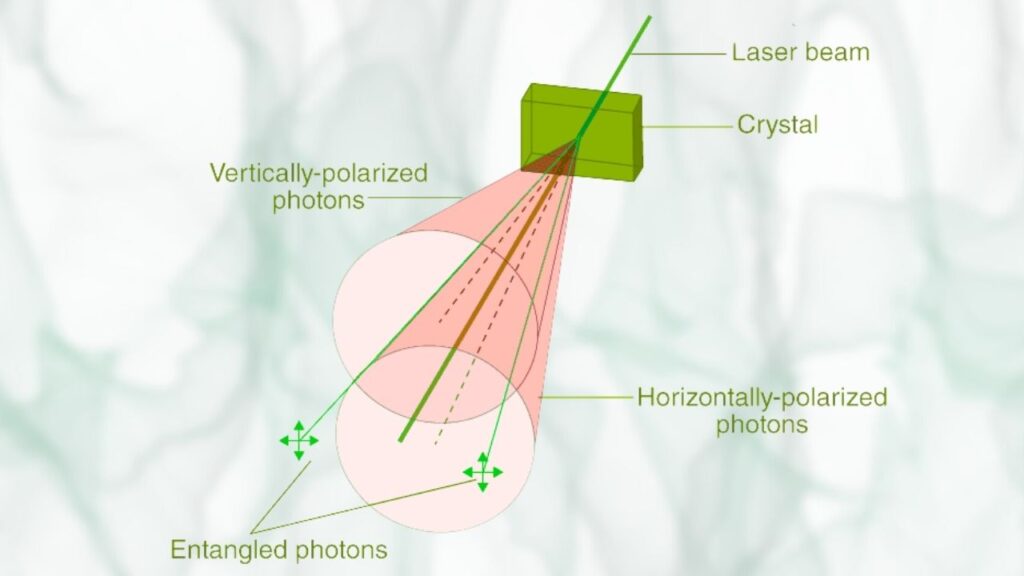
Traditional quantum optics use bulky setups with lasers, crystals, and miles of optical fibers to create and manipulate these entangled photons. The equipment is expensive, sensitive, and hard to scale up. Metasurfaces change all that. Now, you can generate, manipulate, and even “fuse” entangled photons right on a single chip, with no complicated alignment or tuning.
Why Experts Are Excited—In Detail
Miniaturization and Scalability
The first big win is size. Earlier quantum systems took up whole labs, with lasers, mirrors, and delicate optics requiring constant attention. Metasurfaces compress all that complexity into a device that could fit on your fingertip, making quantum computers cheaper, more robust, and more scalable—not just for research labs, but for real-world deployment.
Efficient Multiphoton Entanglement
Multiphoton entanglement is a gateway to more powerful quantum machines. With traditional setups, generating entangled photon clusters becomes exponentially tricky as you add more qubits. Metasurfaces, however, have now demonstrated the ability to fuse several pairs of entangled photons into larger groups right on a single chip, all thanks to the engineered interactions of nanostructures on the surface. This could dramatically boost the amount of information a quantum computer can process at once.
Error Resistance, Low Loss, and Robustness
Loss—when photons get lost or absorbed before they can do useful work—is a major headache for quantum systems. Traditional optics lose photons due to misalignment, scattering, and imperfect components. Metasurfaces, being flat and solid-state, are less prone to these problems. Their planar geometry maintains alignment automatically, and their low-loss materials maximize the number of photons that survive to participate in quantum operations. This makes for more reliable, longer-lived quantum states—a must for practical quantum computing.
Programmability and Versatility
Many metasurfaces are programmable: using electronic or optical signals, you can change how they manipulate light without changing the hardware itself. Researchers have built metasurfaces that can run different quantum algorithms—like Grover’s search or the quantum Fourier transform—on demand, on the same chip. This is a radical departure from the fixed-function hardware of old, opening the door to reconfigurable quantum processors that adapt to new tasks as needed.
Quantum Analog and Hybrid Computation
Metasurfaces are also breaking ground in quantum analog computing. Think of this as a quantum-powered version of a slide rule, where the computer handles continuous values instead of binary bits. Recent research has shown that metasurfaces can reconstruct signal phases—a crucial job for imaging and communication—with high accuracy even at very low light levels, thanks to the use of quantum entanglement sources that boost signal quality. Such analog quantum devices could accelerate everything from imaging tumors in the brain to ultra-secure optical communications.
Quantum Holograms and Beyond
Researchers are also using metasurfaces to create quantum holograms: images where the information is entangled with the quantum state of the light itself. Think of it as an ultra-secure “quantum watermark.” These holograms could be used in anti-counterfeiting, quantum communication, or even quantum-enhanced imaging—all from devices millimeters in size.
Step-by-Step: How a Metasurface Quantum Computer Works
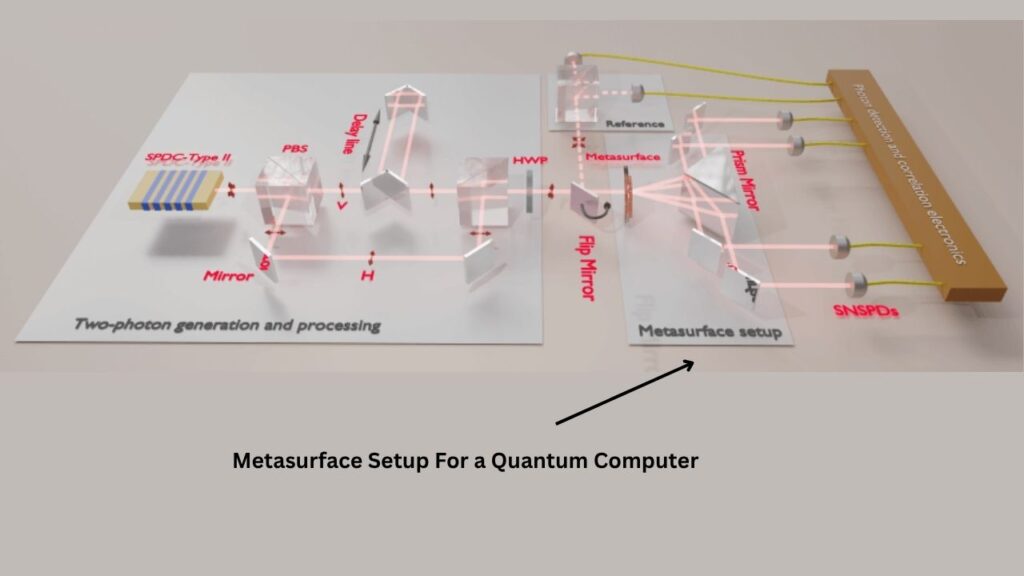
Step 1: Designing the Chip
Engineers use sophisticated computer simulations to design a pattern of nanostructures tailored to the quantum task at hand—say, generating entangled photon pairs or running a Grover’s search. This design is etched into a thin wafer of silicon or glass using nanolithography, a process similar to making microchips.
Step 2: Generating Entangled Photons
A laser shines on the metasurface. The engineered nanostructures cause photons to interact in such a way that they become entangled: one photon’s state instantly determines the other’s, no matter how far apart they are. With the new multiphoton entanglement methods, several photon pairs can be fused into larger entangled clusters, all on-chip and with remarkable efficiency.
Step 3: Manipulating Quantum States
Once the photons are entangled, the same metasurface can split, combine, or otherwise transform them to perform quantum logic operations. Some metasurfaces can even be reprogrammed in real time, switching between different quantum algorithms by changing how they interact with light.
Step 4: Reading the Results
After the photons have passed through the metasurface, they’re caught by sensitive detectors. The pattern of light (or rather, its quantum state) tells scientists the result of the computation—for example, whether a search has succeeded or a molecule’s structure has been simulated.
Practical Advice for Professionals and Students
For researchers and engineers:
- Collaborate early with nanophotonics and materials science labs to access cutting-edge fabrication tools.
- Think modularly: Metasurfaces can serve as plug-and-play components in larger quantum systems, simplifying integration and reducing costs.
- Design for scalability: Plan for metasurfaces to interface with quantum sensors, networks, and classical electronics.
- Optimize algorithms for the unique advantages of metasurfaces, especially their ability to handle multiphoton entanglement and on-chip programmability.
For students and early-career professionals:
- Skills in nanofabrication, optical simulation, and quantum information theory are in growing demand as metasurface-based quantum devices mature.
- Keep up with conferences like META 2025, where cutting-edge research in nanophotonics and quantum technologies is showcased.
- Consider internships or research projects focused on quantum optics, metadevices, or hybrid quantum-classical systems.
Career Opportunities and Industry Impact
The growth of metasurface quantum technology is creating demand for quantum engineers, nanofabrication specialists, optical physicists, and quantum algorithm developers. These skills are relevant in industries from healthcare imaging to secure communications, and even artificial intelligence as the lines between quantum and classical computing blur.
Companies working on metasurfaces for quantum applications include startups, semiconductor giants, and academic spinoffs—all racing to bring scalable, reliable quantum devices to market.
Challenges and Realistic Expectations
Metasurfaces are not a silver bullet—yet. There are significant hurdles to overcome before we see metasurface-based quantum computers on every desk:
- Qubit capacity: Current metasurfaces handle only a limited number of qubits. Progress in nanostructure design and materials is needed to scale up.
- Loss and decoherence: While metasurfaces reduce loss compared to traditional optics, further progress is essential for large-scale quantum circuits.
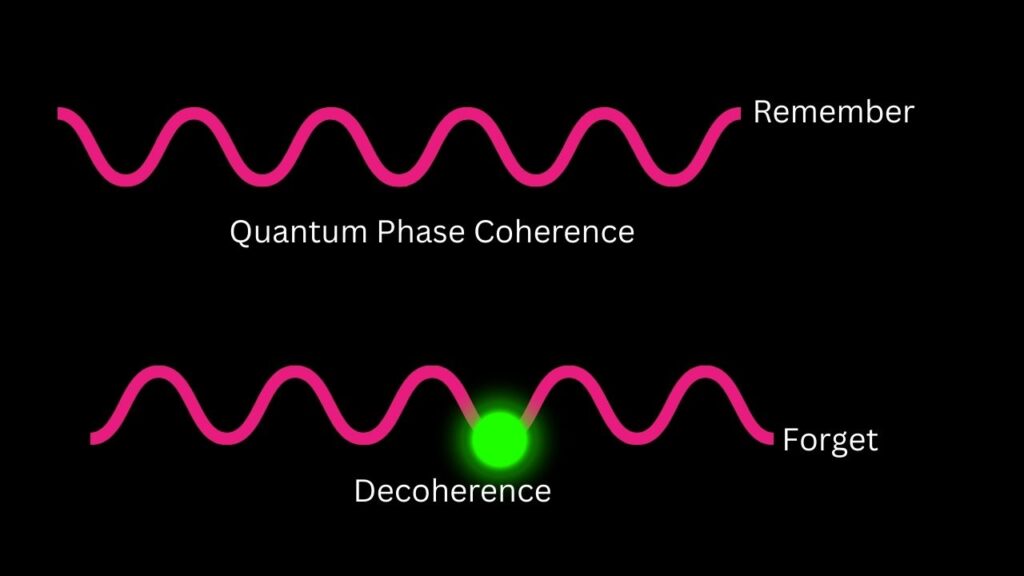
- Material and fabrication: Today’s metasurfaces are mostly made with standard semiconductors and metals. Future breakthroughs may require novel materials to achieve even greater control and performance.
- Integration: Seamlessly combining metasurfaces with quantum detectors, light sources, and electronics is still a research challenge.
Timeline expectations: Most experts agree that metasurface-based quantum devices will make meaningful impacts in research and specialized applications by the end of this decade. Broad commercialization may take longer, but the pace of innovation is rapid.
Quantum Computing Reaches New Heights: Transmon Qubit Coherence Shatters the Millisecond Barrier
New Cryogenic Silicon Chip Offers Breakthrough in Managing Spin Qubits for Quantum Computing
Oxford’s 1-in-6.7 Million Qubit Leap Could Redefine the Future of Quantum Computing
FAQs About Metasurfaces Could Be the Future of Quantum Computing
Q: What exactly is a metasurface?
A metasurface is an ultrathin sheet of nanostructures—each smaller than a wavelength of light—that can precisely control light’s phase, amplitude, and polarization. This allows for advanced optical functions (like lensing or splitting light) in a tiny, planar device.
Q: How do metasurfaces help quantum computing?
They miniaturize and stabilize quantum optical setups, simplify entanglement generation, reduce errors, and enable programmable quantum operations—all on a single chip that fits on your fingertip.
Q: Are metasurfaces used in today’s quantum computers?
Most quantum computers today use other technologies (like superconducting circuits or trapped ions), but metasurfaces are rapidly advancing in research labs. They could enter mainstream quantum hardware within this decade.
Q: Can metasurfaces be reprogrammed for different tasks?
Yes, some metasurfaces are programmable, allowing them to perform different quantum algorithms without changing the physical hardware.
Q: What are the main technical challenges?
Scaling up to more qubits, reducing optical loss, developing new materials, and integrating metasurfaces with other quantum technologies are the biggest challenges.
Q: What new applications are possible with metasurface quantum devices?
Quantum imaging, secure communications, anti-counterfeiting, analog quantum computing, and even quantum artificial intelligence are all on the horizon.

